By:Craig Andresen and Diane Sori / Right Side Patriots on American Political Radio
Be sure to Click LIKE at the bottom of this article, and share it everywhere!!
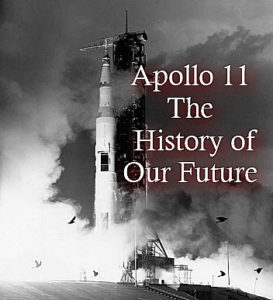 50 years ago, the timeline was impossible, the task nearly beyond comprehension, and the men who made history were extraordinary.
50 years ago, the timeline was impossible, the task nearly beyond comprehension, and the men who made history were extraordinary.
In a way, I feel sorry for anyone who is 50 years of age, or younger. Sure, they can read about it, or talk to folks who are even just slightly older than that about it, but they didn’t experience it, and it was an experience those of us who were young at the time, barely old enough to begin to understand such things will likely never forget.
July 20th, 1969, is what most remember as the date man first set foot on the Moon, but that’s not even close to when it started. To truly understand the time frame, one has to back themselves up through the Apollo program, before Gemini, and before Mercury. Go back to a point in time before being in space, before the breaking of the sound barrier, and even earlier than manned flight.
Think of it. For 200,000 plus years, mankind had looked at the Moon, dreamt about it, prayed to it, revered it, feared it, and assigned to it any number of various scenarios. Mankind misunderstood the Moon for better than 200,000 years, but never gave up trying to learn about it. The Moon, always there, a source of light when the sun went down. A measure of time, and seasons, and tides. Mysterious, so far away. So close it  could almost, but not quite be touched. A neighbor we never really knew.
could almost, but not quite be touched. A neighbor we never really knew.
That was all about to change, but to really understand how we got there, one must first understand why we went there.
It was a race, the space race, and we were losing. Today, the Russians have become the excuse for what happened in November of 2016. Back when the space race began, the Russians were the reason, not the excuse. Politics, and the cold war brought the United States and the Soviet Union, Americans and Russians to the starting line. The race would prove, once and for all, who was technologically superior, and space is where that race would be run, won, and lost. The Russians got off to a head start. Sputnik, that tiny, shiny metal beeping ball. The Soviet Union had managed to orbit an object around the earth.
The United States was in second place, and in any two competitor race, second place was last place. Make no mistake, those early rockets that carried first, a Russian made satellite and then, an American made satellite, and later would carry men into space in those early days were nothing more than military missiles whose nosecones had been removed and replaced with a capsule barely big enough to hold a human, and technological superiority also meant military superiority. Getting a man into space? The Russian’s Yuri Gagarin led that leg of the race over our Alan Shepard. Orbiting a man around the earth? Yuri Gagarin was first, John Glen was second. The first spacewalk? Alexei Leonov from the Soviet Union did it before our own Ed White did it.
All those things were but markers along the way. The starting line was just getting something, anything into space, but the finish line, where the winner and the loser would be clearly defined, where technological superiority would be forever set in stone was the Moon – getting men to the Moon, and bringing them back alive. We were behind one step, every step of the way. We needed something, some sort of motivation, a pep-talk, and we got one from President John F. Kennedy.
When Kennedy made that speech, telling us, and the Soviets that the United States would send men to the Moon by the end of the decade, and return them safely to earth, it was September, 1962. We had just barely put John Glenn into orbit before that speech, and for even more stunning context, it had only been a scant 35 years since Charles Lindbergh had become the first to fly solo across the Atlantic Ocean. The craft Kennedy spoke of that day had not been built, some of the materials for it had not even been invented, and the technology needed to guide it wouldn’t even fit in a room, much less a tiny capsule. That speech was beyond bold, but this was America, exploration was our driving force, and losing was not an option.
The Mercury program was one man at a time. Gemini put two men at a time atop a ballistic missile and hurled them into space. Those were tests meant as a learning curve crash course, but NASA would have to step it up if Kennedy’s bold prediction had any hope at all. Of course, in September of 1962, everybody thought Kennedy would be there if, and when it happened. By late November, 1963, that bold American promise was all there was left of President Kennedy. Success would be his legacy, and failure became unthinkable.
NASA built the biggest rocket ever made, the Saturn V, a crew capsule that would hold 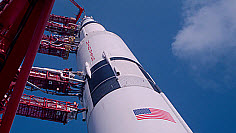 three astronauts, and a Lunar Excursion Module that would take two of them to the surface of the Moon from materials not yet proven. They equipped the new vehicles with technology never used before, and they invented materials for suits the astronauts would wear that would stand up to the environment and substance of the lunar surface, whatever it was, because at that point, it was anyone’s guess. This was the old NASA, where the things they figured they would need weren’t designed in or run through simulations on computers. They were designed by people with slide rules, and tested by trial and error.
three astronauts, and a Lunar Excursion Module that would take two of them to the surface of the Moon from materials not yet proven. They equipped the new vehicles with technology never used before, and they invented materials for suits the astronauts would wear that would stand up to the environment and substance of the lunar surface, whatever it was, because at that point, it was anyone’s guess. This was the old NASA, where the things they figured they would need weren’t designed in or run through simulations on computers. They were designed by people with slide rules, and tested by trial and error.
A terrible error occurred on January 27th, 1967 when all three members of the Apollo 1 crew were tragically killed in a launch pad fire while practicing for their flight which was to have taken place in February. NASA had sacrificed safety for speed. They were using pure oxygen inside the Command Module, and there was no latch for the hatch on the inside of the capsule. Something sparked, a fire started inside, the pure oxygen created a blow-torch effect, and Gus Grissom, Ed White and Roger Chaffee were trapped. By the time safety crews were able to open the hatch, it was far too late. All three astronauts were dead, and the entire program was in jeopardy. But this was the old NASA. Today’s NASA would have gone dark to the outside world for nearly a decade while they studied every minute detail of what went wrong just as they did after Challenger.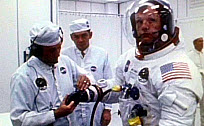
The old NASA ordered fixes, plans on the desk by the end of next month, work around the clock to reengineer the design, and don’t slow down. Both houses of Congress investigated the fire, a few key people at NASA were replaced, the new design was put into production and while all of those things were happening, work was finished on the lunar lander. In November of 1967, just 10 months after the launch pad fire, Apollo 4, unmanned, was launched. That was followed by two more unmanned Apollo test flights in January and April of 1968, and despite glitches and problems, NASA made them all work using spur of the moment corrections, fixes and alternate systems while in flight to make those tests successful.
Suddenly, the United States had pulled even in the race, and with the first manned Apollo flight, Apollo 7, we took the lead in the race to the Moon, and we never looked back.
Apollo 8 took a crew of three into orbit around the moon. The Russians had never done that. Apollo 9 tested the docking apparatus and procedure between the Command Module and the Lunar Module. The Russians had never done such a thing. Apollo 10 tested the maneuverability of the Lunar Lander in orbit around the Moon, getting within 50,000 feet of the lunar surface, while all the Russians could do was watch.
On July 16th, 1969, Michael Collins, Buzz Aldrin, and Neil Armstrong lifted off from launch pad 39A in a machine that was, for that time, state of the art. By today’s standards, it had all the computing power of a basic pocket calculator, and not one bit more. Four days later, On July 20th, 1969, Aldrin and Armstrong used all but the last 15 seconds of descent fuel to bring the Lunar Module, the Eagle, to a soft landing on the Sea of Tranquility. Then, at 15 seconds past 9:56pm central time, a kid, just 4 months short of being 9 years old, and sitting in front of a black and white TV in Lincoln, Nebraska, along with an estimated 650 million other people from around the world watched, and listened in absolute awe as Neil Armstrong, an American astronaut, won the race.
While Armstrong, and Aldrin walked on the Moon, gathered rocks and soil samples and planted an American flag, Michael Collins was orbiting, making observations, taking photos and standing ready to perform the most important job of the mission, be in the right place, at the right time, to dock with the Lunar Module because without him, and his expertise, none of them would make it home.
I,Craig Andresen, was 8 years old. I knew the names of more astronauts than I did names at my own family reunion. I could recite, chapter and verse, every space mission we had ever flown, and in the middle of that Sunday night in late July of 1969, there was no doubt that I lived in the greatest nation on earth. I would never look at the Moon the same way again, and my perception of Collins, Aldrin and Armstrong changed that night too. They were no longer astronauts. They were heroes.
Armstrong is gone now. Aldrin is iconic, and Collins is 88 years old, but as we look back 50 years, remembering what is was like, Collins spoke recently of the label I, and the world bestowed upon him, and the others from Apollo 11.
“We didn’t do anything above and beyond the call of duty. We did what we had been hired to do. It may have been tremendous and unusual, but I think it’s a disservice to people who are hard-working people, like nurses and doctors and the like, who deserve to be heroes. We’re just regular astronauts.”
It may seem like we haven’t done much in space since the last days of Apollo, and maybe that’s because it was so momentous that other achievements over the past 50 years seemed less glamorous, but as someone whose interest in our space program has never waned, I can assure you of two things…whether it was one small step, or one giant leap, getting to the Moon and home again safely was only the beginning, and with all due respect to the humility of Michael Collins…sir, there is no such thing as a “regular astronaut.”
And so on July 20, 1969…at exactly 10:56:15 p.m. Eastern Daylight Time…the course of human exploration was forever changed as we finally broke free of the stone tools of the 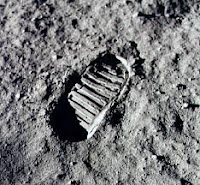 past for what was once thought impossible indeed became possible. And as one man in the name of all men left behind footprints that remain untouched to this day, man’s quest to touch the stars truly began. And while there have been some hurdles that needed to be overcome, there remained those working quietly behind the scenes who kept man’s quest for knowledge ongoing. And that quest will now finally take man back to the Moon, then onto Mars, and into deep space thereafter.
past for what was once thought impossible indeed became possible. And as one man in the name of all men left behind footprints that remain untouched to this day, man’s quest to touch the stars truly began. And while there have been some hurdles that needed to be overcome, there remained those working quietly behind the scenes who kept man’s quest for knowledge ongoing. And that quest will now finally take man back to the Moon, then onto Mars, and into deep space thereafter.
Sadly though, many who aided Neil Armstrong in his quest to place the “Stars and Stripes” on the surface of the Moon are no longer with us, yet their dreams have now become the reality of the newest generation of space explorers…explorers who will soon venture out to worlds far from home and other explorers who will not only make those journeys possible, but who will chart the paths of where we are to go and make sure that all who physically explore return safely home. And my older son is now such an explorer…he’s living my dream of being part of space exploration and I, Diane Sori, could not be more proud…as he’s helping in the search for answers to questions I hope can be answered within both his and my lifetime.
And to date, only twelve courageous men have walked upon the Moon’s surface. Neil Armstrong led the way on July 20th 1969, and on December 11, 1972, a Saturn V rocket was launched with Apollo 17 signaling the end of man’s walking upon ground not of Earth’s own. Gene Cernan, the 12th and last man to walk the lunar surface said these words before beginning the trip home. “We shall return.”
“Under my Administration, we are restoring @NASA to greatness and we are going back to the Moon, then Mars.” – President Trump’s words, March 2019
And now a half century later that long awaited return is about to begin as President Donald J. Trump’s dream of space exploration picks up where JFK’s dream left off. But why has it taken America so many decades to continue on a journey we have always been bound to follow? The answer quite simply lies within the mundane nature of both politics and priorities as a shift in priorities quelled the desire of elected officials to implement new and even costlier missions to the Moon and beyond. Examples of such priority switches can been be seen in the major oil crisis of 1973, and in today’s “War on Terror” which is expected to cost we taxpayers over $5 trillion dollars in the long run. That coupled with America having proved itself to be the winner of the so-called “Space Race,” saw support for much of the efforts required to again return man to the Moon simply not being there.
But did that mean America lost its desire to explore both the wonders and possibilities of space…thankfully it did not for all it saw was a shift in the actual physical aspect of how we would accomplish said exploring. And while “Low Earth Orbit” activities such as the Skylab program, the Space Shuttle program, and the International Space Station took up the bulk of NASA’s funding over the next few decades, more recent robotic probes and satellites… like the Mars Pathfinder and the Mars exploration rovers Opportunity, Spirit, and Curiosity… have helped put NASA back in the spotlight with returning to the Moon now truly becoming a 2024 reality, and maybe even seeing man step foot on Mars by the next decade’s end.
Thank you President Trump.
And not to be forgotten is what truly lies beyond just going to the Moon and to Mars for our curiosity has been peaked via the wonders we’ve seen courtesy of the Hubble and Kepler Telescopes…both being mankind’s eyes into deep space. Hubble, launched from the shuttle Discovery on April 24th 1990, does not travel to the stars, but takes pictures of them as it circles around Earth at about 17,000 mph. And with it circling outside the “haze of our atmosphere,” Hubble has an unobstructed view of the universe as it searches for and observes the most distant stars and galaxies as well as the planets within our own solar system. In fact, the Hubble Telescope has actually peered back into the distant past to view galaxies and stars more than 13.4 billion light-years from Earth. And in its more than 25 years of operation, the more than 1.3 million observations it has sent back have not only opened our eyes to the sheer wonders of space, but to the possibilities those wonders hold for mankind.
And while the Kepler Telescope was specifically designed to explore both the structure and diversity of planetary systems within our region of the galaxy we call the Milky Way…Kepler was also designed to “discover” if there are any Earth-size or smaller planets in or near the “habitable zone”…and know there are most likely many…as well as to determine the fraction of the hundreds of billions of stars in our galaxy that actually might have such planets. And like with the Hubble telescope, Kepler has opened up possibilities few have ever dreamed of.
And let’s not forget that on December 10, 2018, Voyager 2 exited the heliosphere…the protective bubble of particles and magnetic fields created by the Sun…and joined Voyager 1 in its travels through interstellar space…space outside the reach of our solar system… something else once thought impossible now also becomes open to endless possibilities.
But before those possibilities can truly be explored baby steps must first be taken. And with the Moon being a “close natural laboratory”…a laboratory by which man can look for the answers to the fundamental questions about both the origin and evolution of the Earth and our solar system…it makes sense that going back to the Moon be that first baby step taken. Remember, without successfully succeeding with the small steps, the risk of failure becomes an option some might think not worth taking.
And groundwork for that first baby step was set back on June 18, 2009, when atop an Atlas V rocket both the Lunar Reconnaissance Orbiter (LRO) and the Lunar Crater Observation and Sensing Satellite (LCROSS) were launched. Spending its first three years in a low polar orbit collecting detailed information about the lunar environment, LRO transitioned to a stable elliptical orbit where it continues to this day to collect and relay back to Earth important data, photographs, and information. Deemed essential for planning NASA’s future manned missions to the Moon, LRO’s observations have shown the Moon to be not a dead object circling the Earth, but a “dynamic and complex body” that’s helping to set up the scientific framework needed in regards to building a permanent manned lunar base. And because it takes high resolution images of the lunar surface, LRO was able to detect ice at the poles..ice as in water…which is key to us building a permanent base on the Moon.
And after we return to the Moon it’s on to our neighbor Mars with maybe a short side trip to Titan or an asteroid or two…the possibilities are endless…we just need the brain power and the funding to see all those possibilities through. And that in turn raises the question about the very nature of the baby steps we will soon be taking for many are now asking why doesn’t NASA save money by just digging out the old Apollo designs and use them to put men back on the Moon possibly even before Trump’s 2024 ETA. That’s not quite as simple as some might think for technology itself has greatly changed in the fifty years since Neil Armstrong’s then and President Trump’s now.
Simply, the experience and knowledge needed to travel to Mars is way more complex in nature than it is to return to the Moon. The old technologies used in getting us to the Moon back in the 1960’s would never suffice in getting us to Mars today, so from both a logistical and a cost scenario we need to be able to adapt newer “get us to the Moon” technologies as a jump off point to get us to Mars.
As President Trump has stated, those two missions are intrinsically tied together.
And besides, the old Apollo blueprints do not take into account how we would be constructing a much needed sustained manned presence on the Moon let alone how we would get the equipment needed to construct such a presence to the Moon…as in a base that would actually allow for the production of the consumable resources needed by those going to Mars…as in life support, radiation protection, as well as interplanetary propulsion. Remember, when we go to Mars and beyond, most likely we will not be departing from Earth but from the Moon, and at times it will require more propulsion power than a mere Saturn V rocket carrying a capsule containing but three men.
But before we even head back to the Moon in 2024, we will be going back to Mars next year as part of NASA’s Mars Exploration Program, a long-term robotic exploration of the Red Planet. And this mission will lead the way to future manned Mars landings.
Referred to in some circles as a “biological mission,” this mission will address key questions about the potential for life on Mars. Seeking signs of habitable conditions on Mars in the ancient past, this Mars rover…a rover the size of a van…will also search for signs of past microbial life. Equipped with a special drill that can collect all-important core and soil samples, this newest rover will provide opportunities to demonstrate technologies that directly address critical challenges man would face going to Mars…including but not limited to testing a method for producing oxygen from Mars’ atmosphere, identifying other resources (such as subsurface water), improving landing techniques, and characterizing weather, dust, and other possible environmental conditions that could affect future astronauts living and working on Mars.
Aiming for a launch in July or August of 2020 when Earth and Mars are in relatively close proximity to each other thus needing less power to travel to the Red Planet…to keep mission costs and risks as low as possible, the Mars 2020 mission design is based upon NASA’s 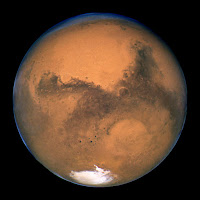 successful Mars Science Laboratory mission including its Curiosity rover and proven landing system. And some will again of course say if previous Mars mission blueprints are being used why not use the Apollo blueprints…well how about the key fact that Mars technology is as far removed from Apollo technology as Apollo technology was from the compasses that guided Columbus’ ships.
successful Mars Science Laboratory mission including its Curiosity rover and proven landing system. And some will again of course say if previous Mars mission blueprints are being used why not use the Apollo blueprints…well how about the key fact that Mars technology is as far removed from Apollo technology as Apollo technology was from the compasses that guided Columbus’ ships.
But the bottom line remains…returning to the Moon is the first step needed to begin manned exploration of Mars. And from knowledge garnered from a permanent Moon base we will garner the information needed for a permanent presence on Mars. The need to explore the unknown is embedded within our genes…glad I passed that gene down to my son for he is now part of space exploration and once again I could not be more proud.
So as we celebrate 50 years since that first “small step,” know that our return to the Moon within the next few years will be more practical than political, and a question man has long asked might finally be answered. And while that answer might not be what some want to hear, getting to that answer will be one hell of a ride.
Copyright @ 2019 Diane Sori and Craig Andresen / Right Side Patriots / All Rights Reserved.
*************************************************************************************************
Friday, July 19th, from 7 to 9pm EST on American Political Radio, RIGHT SIDE PATRIOTS Craig Andresen and Diane Sori discuss ‘Apollo11…The History of Our Future’; and important news of the day.
Hope you can tune in at: http://listen.samcloud.com/w/73891/American-Political-Radio#history…or on Tune-In at:https://tunein.com/radio/American-Political-Radio-s273246/





